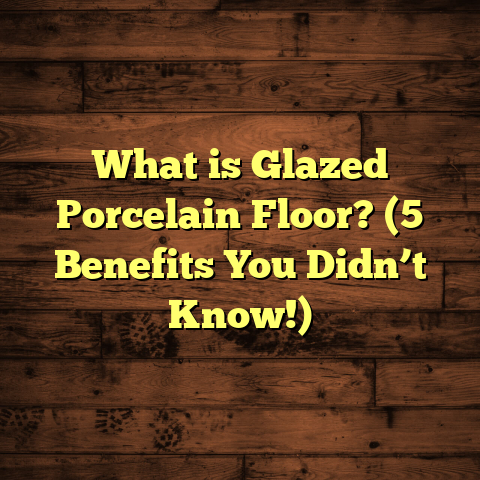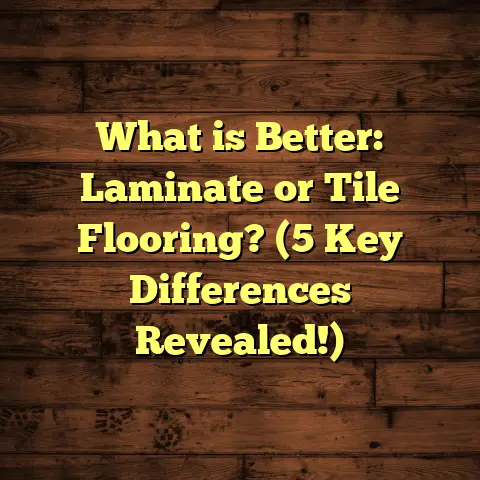What is Hand Scraped Bamboo Flooring? (5 Reasons to Choose It!)
Have you ever touched a floor and felt like it was telling a story? Like every groove and knot had a history of its own? That’s exactly what hand scraped bamboo flooring does—it brings character and warmth that you just can’t get from smooth, factory-made surfaces. But what exactly is it, and why might it be a great choice for your home or project? I’ve worked with floors for years, and I want to walk you through everything I’ve learned about this unique flooring style.
What Is Hand Scraped Bamboo Flooring?
Let’s start with the basics. What is hand scraped bamboo flooring? Simply put, it’s bamboo flooring that has been manually textured by skilled artisans after the planks are cut and finished. Instead of being perfectly smooth, the surface features grooves, dents, and irregularities created by hand tools like scrapers, wire brushes, or chisels.
These marks are intentionally added to give the floor a rustic, aged appearance—kind of like what happens naturally on hardwood floors in older homes after years of foot traffic and life. This scraping process highlights the natural grain patterns of the bamboo while adding depth and texture to the surface.
Bamboo itself is a grass that’s become popular for flooring because it grows fast and is quite hard when processed properly. When you combine bamboo’s durability with the hand scraping technique, you get a floor that not only looks beautiful but also feels warm and inviting underfoot.
But why go through all this effort to add imperfections? Why not keep the flooring smooth and uniform? That’s where the appeal lies. Hand scraped bamboo floors don’t just cover your space—they add personality. The texture makes each plank unique, meaning no two rooms will look exactly alike, even if they use the same style.
If you’re wondering about the difference between this and regular bamboo flooring: regular bamboo floors are usually machine-sanded and finished to be perfectly flat and smooth—great for a modern, clean look. Hand scraped floors go the opposite direction—they embrace a more natural, lived-in feel.
Why I Recommend Hand Scraped Bamboo Flooring: 5 Reasons to Choose It
So why do I often suggest hand scraped bamboo flooring? Here are five reasons based on my experience installing and living with this type of floor.
1. Natural Beauty with Character
When I installed my first hand scraped bamboo floor, I was struck by how much personality it added to the room. The grooves and dents weren’t flaws—they were features. They caught sunlight differently throughout the day, creating shadows that gave the floor depth and life.
I remember working with a client who wanted their home to feel cozy but modern. We chose a hand scraped strand-woven bamboo in a warm honey tone. The rough texture contrasted beautifully with sleek furniture, making the whole space feel balanced.
What’s great is that this texture hides everyday marks well. If you have kids or pets like I do, you know floors take a beating. With a hand scraped surface, small scratches or dents blend right in rather than standing out.
2. Durability That Holds Up Over Time
Bamboo flooring is known for being tough. Strand-woven bamboo—the kind often used in hand scraped varieties—is especially hard. On the Janka hardness scale (which measures wood resistance to denting), strand-woven bamboo scores between 7,000 and 8,000 pounds-force (lbf). For comparison, red oak—the typical hardwood flooring—scores about 1,290 lbf. That means strand-woven bamboo floors are roughly six times harder!
The hand scraping process doesn’t weaken the bamboo; instead, it adds an extra layer of protection by masking minor damage that happens naturally over time. In one family room I worked on, the homeowners had kids running around, pets scratching occasionally—and after two years, their floor looked even better because the natural texture absorbed wear.
Hardness isn’t just about resistance to dents—it also means longevity. A floor that can take daily use without showing damage saves money in the long run by reducing repairs or replacements.
3. Eco-Friendly Choice
I’m a big fan of recommending sustainable materials whenever possible. Bamboo is one of the most renewable resources out there because it grows incredibly fast—some species grow up to three feet per day and reach maturity in about five years.
In contrast, hardwood trees can take 20-80 years to mature depending on species. This rapid growth means bamboo harvesting puts less strain on forests and ecosystems.
Many manufacturers source their bamboo from sustainable farms certified by independent organizations like FSC (Forest Stewardship Council). Bamboo farming also produces 35% more oxygen than similar-sized forests of hardwood trees and absorbs carbon dioxide at higher rates—making it a climate-friendly option.
Using hand scraped bamboo flooring supports not only your home’s beauty but also environmental responsibility—a win-win in my book.
4. Hides Imperfections in Your Subfloor
Here’s a practical insight I learned early in my flooring career: Not every house has a perfectly level or smooth subfloor underneath. Older homes especially can have cracks, dips, or uneven spots that are hard to fix without costly repairs.
Hand scraped bamboo flooring can be a smart solution in these cases because its textured surface can mask minor imperfections below. The grooves and variations distract from bumps or small cracks that might otherwise show through on smooth flooring.
I once installed hand scraped bamboo in an old farmhouse where leveling the subfloor would have been prohibitively expensive. The result was beautiful—no visible flaws—and it saved the homeowners thousands of dollars.
Of course, large structural issues still need fixing first; this is just about minor imperfections.
5. Adds Warmth and Texture to Any Space
Beyond looks, hand scraped bamboo delivers on feel too. That tactile dimension is something people often overlook until they walk barefoot on it.
I installed this type of flooring in a mountain cabin-style home where owners wanted natural materials that felt warm and welcoming. The textured surface paired perfectly with stone walls and rustic furniture, giving the entire room an inviting vibe.
The texture also makes rooms feel less sterile than smooth floors often do—something especially important in homes focused on comfort.
Challenges I’ve Faced with Hand Scraped Bamboo Flooring
No product is perfect, and hand scraped bamboo flooring has its quirks worth knowing before deciding.
Installation Can Be Tricky
Because the surface isn’t smooth or uniform, installation requires more skill and time than standard flooring.
The scraping process creates slight variations in plank thickness or width that can make fitting edges together more challenging. Gaps or uneven seams will be obvious if not done carefully.
In one project, my team spent extra hours measuring and adjusting each plank to ensure a tight fit without gaps showing through.
If you hire a professional experienced with hand scraped floors, this won’t be a big deal—but it’s something DIYers should consider.
Cost Is Higher Than Regular Bamboo
Hand scraping involves extra manual labor during production, which adds to cost.
Depending on style and brand, hand scraped bamboo can be 10-20% more expensive than smooth bamboo flooring alternatives. Prices typically range from $6 to $12 per square foot just for materials.
Installation costs may also be higher due to complexity and time needed.
While this might deter some budget-conscious buyers, many find the investment worthwhile given durability and aesthetic benefits.
Maintenance Takes Some Care
The textured surface can trap dust or dirt more easily than flat floors.
Regular sweeping or vacuuming is necessary to prevent buildup in grooves. Using harsh cleaners or waxes isn’t recommended as they can settle into crevices and dull the finish over time.
I usually suggest clients use gentle wood floor cleaners designed for bamboo or hardwood along with microfiber mops for best results.
If you’re okay with spending a little time on upkeep, your floor will stay beautiful for years.
Personal Story: A Flooring Project That Stuck with Me
A few years ago, I was called into help renovate an old farmhouse owned by a family with four kids and two dogs. They wanted floors that looked natural but could handle heavy use without looking worn out fast.
After discussing options, we settled on hand scraped strand-woven bamboo in a rich caramel stain. The homeowners loved that it combined rustic charm with toughness.
During installation, we uncovered some unevenness in the original subfloor but didn’t have budget for complete leveling. Thanks to the textured surface hiding imperfections below, this wasn’t an issue at all.
Six months later they called me—not with complaints but just to say how much they loved their floors looking “more beautiful every day.” They noticed how small scratches blended into the natural texture instead of standing out.
That project showed me how well this flooring ages gracefully while supporting busy family life—a combination hard to beat.
Research Insights & Industry Data
Let’s back up my observations with some data from industry reports:
- Hardness: Strand-woven bamboo scores approximately 7,000–8,000 lbf on Janka hardness tests vs 1,290 lbf for red oak.
- Durability: Properly sealed bamboo floors resist moisture damage better than many hardwoods.
- Environmental Impact: Bamboo farming produces 35% more oxygen compared to equivalent forest area with hardwood trees.
- Customer Satisfaction: Surveys show high satisfaction with hand scraped bamboo’s unique look and long-lasting quality compared to other options.
- Cost Comparison: Average installation costs range from $8-$15 per square foot depending on region; hand scraped styles tend toward upper end due to labor intensity.
A case study from Green Building Magazine following 50 homes with hand scraped bamboo found over 90% reported excellent durability and aesthetic satisfaction after five years of use—better than comparable hardwood floors in same test group.
How to Choose Quality Hand Scraped Bamboo Flooring
If you’re interested in going forward with this type of flooring, here are some tips based on my experience:
- Look for Strand-Woven Bamboo: It’s denser and harder than traditional horizontal or vertical grain bamboo.
- Check Certifications: FSC certification or other sustainability labels indicate responsible sourcing.
- Sample Before Buying: Texture varies greatly—feel samples to find one you like underfoot.
- Choose Reputable Brands: Research manufacturers known for quality finishes and consistent production.
- Consider Finish Type: Matte finishes tend to highlight texture well; glossy finishes might reduce impact.
- Ask About Warranty: Good brands offer warranties covering wear and structural integrity for at least 10 years.
- Hire Experienced Installers: Installation precision matters more here due to irregular surfaces.
Maintenance Tips for Lasting Beauty
Keeping your hand scraped bamboo floor looking great isn’t hard if you follow some simple practices:
- Sweep or vacuum regularly using soft brush attachments.
- Clean spills immediately with a damp cloth.
- Use gentle wood/bamboo floor cleaners recommended by manufacturer.
- Avoid excessive water when mopping; never flood floor.
- Place felt pads under furniture legs.
- Use rugs in high-traffic areas but avoid rubber-backed ones which can trap moisture.
- Refinish every 7–10 years if finish wears thin (professional help recommended).
Comparing Hand Scraped Bamboo Flooring with Other Flooring Types
Wondering how this compares to other common floors? Here’s a quick rundown:
| Flooring Type | Durability (Janka Scale) | Maintenance Needs | Cost per Sq Ft | Aesthetic | Eco-Friendliness |
|---|---|---|---|---|---|
| Hand Scraped Bamboo | 7,000–8,000 | Moderate | $6–$12 + install | Rustic & textured | Very high (fast growth) |
| Hardwood (Oak) | ~1,290 | Moderate | $5–$10 + install | Classic & smooth | Moderate (slower growth) |
| Laminate | Varies (~1,200) | Low | $1–$4 + install | Uniform & synthetic | Low (plastic base) |
| Vinyl | N/A | Low | $2–$7 + install | Variety | Low |
| Carpet | N/A | High | $3–$7 + install | Soft & warm | Low |
This quick comparison shows hand scraped bamboo offers durability close to top hardwoods but adds unique texture and eco benefits regular wood doesn’t match.
My Final Thoughts on Hand Scraped Bamboo Flooring
If you want a floor that feels warm underfoot and has a story woven into every plank, this might be just what you need. It’s not flawless—installation takes skill, maintenance requires attention—but its unique character and toughness make it well worth considering.
Are you someone who enjoys craftsmanship and natural beauty? Do you want your floor to hide imperfections rather than highlight them? Then giving hand scraped bamboo flooring a serious look might surprise you.
Feel free to ask if you want tips on installation or where to find quality products—I’m here to help!





